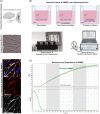The neurovasculature as a target in temporal lobe epilepsy
- PMID: 36599709
- PMCID: PMC10041171
- DOI: 10.1111/bpa.13147
The neurovasculature as a target in temporal lobe epilepsy
Abstract
The blood-brain barrier (BBB) is a physiological barrier maintaining a specialized brain micromilieu that is necessary for proper neuronal function. Endothelial tight junctions and specific transcellular/efflux transport systems provide a protective barrier against toxins, pathogens, and immune cells. The barrier function is critically supported by other cell types of the neurovascular unit, including pericytes, astrocytes, microglia, and interneurons. The dysfunctionality of the BBB is a hallmark of neurological diseases, such as ischemia, brain tumors, neurodegenerative diseases, infections, and autoimmune neuroinflammatory disorders. Moreover, BBB dysfunction is critically involved in epilepsy, a brain disorder characterized by spontaneously occurring seizures because of abnormally synchronized neuronal activity. While resistance to antiseizure drugs that aim to reduce neuronal hyperexcitability remains a clinical challenge, drugs targeting the neurovasculature in epilepsy patients have not been explored. The use of novel imaging techniques permits early detection of BBB leakage in epilepsy; however, the detailed mechanistic understanding of causes and consequences of BBB compromise remains unknown. Here, we discuss the current knowledge of BBB involvement in temporal lobe epilepsy with the emphasis on the neurovasculature as a therapeutic target.
Keywords: VEGF/VEGFR; Wnt/β-catenin; angiopoietin/Tie2; blood-brain barrier; cerebral edema; epilepsy animal models; in vitro BBB models; neurovascular unit; temporal lobe epilepsy.
© 2023 The Authors. Brain Pathology published by John Wiley & Sons Ltd on behalf of International Society of Neuropathology.
Conflict of interest statement
The authors declare no competing interest.
Figures



References
-
- Thijs RD, Surges R, O'Brien TJ, Sander JW. Epilepsy in adults. Lancet. 2019;393(10172):689–701. - PubMed
-
- Rosenow F, Lüders H. Presurgical evaluation of epilepsy. Brain. 2001;124(9):1683–700. - PubMed
-
- Willems LM, Hamer HM, Knake S, Rosenow F, Reese JP, Strzelczyk A. General trends in prices and prescription patterns of anticonvulsants in Germany between 2000 and 2017: analysis of national and cohort‐based data. Appl Health Econ Health Policy. 2019;17(5):707–22. - PubMed
Publication types
MeSH terms
LinkOut - more resources
Full Text Sources
Medical
Miscellaneous

